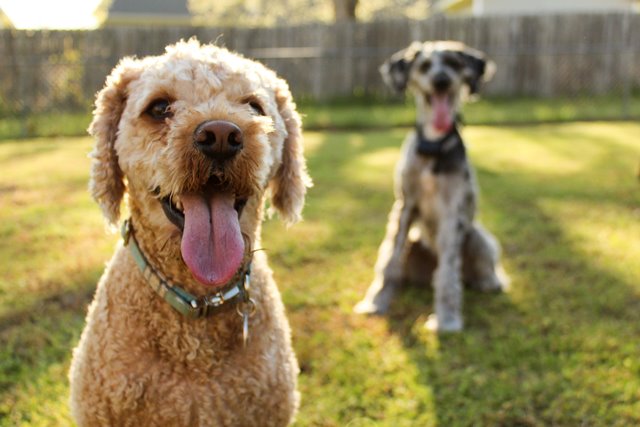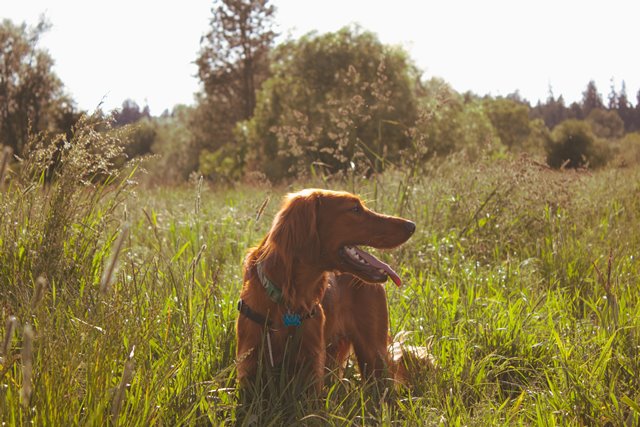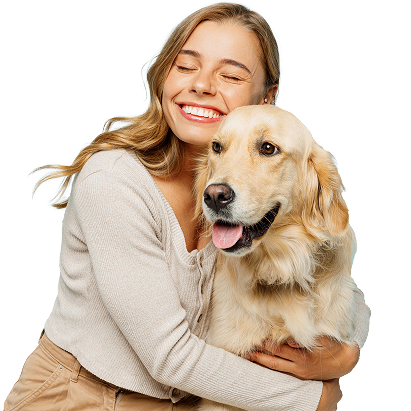Keeping your Dog Cool and Comfortable this Summer
As the days get longer and the weather gets warmer many dog parents will be taking the opportunity to get out and about more with their furry four-legged friends. Whether this includes trips to the beach, mountain hikes, forest trails or simply just evening strolls through the local park it’s important to be aware of […]
As the days get longer and the weather gets warmer many dog parents will be taking the opportunity to get out and about more with their furry four-legged friends. Whether this includes trips to the beach, mountain hikes, forest trails or simply just evening strolls through the local park it’s important to be aware of the biggest danger to your dog at this time of year – heatstroke.
Heatstroke is not just a case of getting a ‘little too warm’, it’s a potentially life-threatening condition that can rapidly make a summer family outing memorable for all the wrong reasons. Follow our tips below to ensure that you and your dog have a safe and enjoyable time this summer.
You can use the links below to jump straight to a section if you prefer:
Why are dogs so susceptible to heatstroke?
Preventing heatstroke in your dog
What is heatstroke?
Heatstroke occurs when body temperature increases to the point where the body’s natural cooling mechanisms are no longer effective and the body literally ‘overheats’. Once the body reaches this point there is a significant risk of damage to the brain, kidneys and other organs which, if rapid action is not taken to cool the body, will result in death. However, it’s important to note that ‘cooling’ needs to be carried out in a controlled manner to prevent a heatstroke victim from going into shock.
There are two main types of heat stroke:
- Exercise-related heatstroke: This generally occurs as a result of intensive exercise or excessive physical exertion – although it’s important to note that dogs with a higher risk of heatstroke can develop heatstroke even with minimal exercise, especially on warmer days.
- Non-exercise related heatstroke – This occurs when a dog is exposed to significant environmental temperature rise (especially when there is a lack of adequate ventilation and/or drinking water to keep cool). This typically occurs in enclosed spaces such as a parked car, or a very hot room such as a conservatory.
Why are dogs so susceptible to heatstroke?
Humans can also get heatstroke but we are much better adapted for naturally cooling our bodies when compared to our canine friends; this means that dogs can easily succumb to heatstroke even on days that may not appear overly ‘hot’ to their human family members. This is due to several key factors:
- Dogs can take up to 2 months to acclimatise to seasonal temperature changes – however, in the UK there is very little opportunity for dogs to naturally and gradually adapt to environmental temperatures as the weather is so variable day by day.
- Dogs cannot sweat the same as humans – We humans have sweat glands all over our skin and when we sweat the water on our skin not only makes us feel cooler but as it evaporates it removes heat from the surface of our skin helping to cool us down further; this is known as ‘evaporative cooling’. Dogs don’t have sweat glands all over their bodies, in-fact most of a dog’s sweat glands are located in the paws; this means sweating does very little to cool a dog down (as the surface area of the paws is very small compared to the rest of the dog’s body).
- Dogs are wearing a permanent fur coat! – As the weather outside heats up we humans can don our shorts and tee-shirts allowing more air to circulate around our skin, actively cooling us. Dogs have very little exposed skin due to their fur coats which actually act to trap ‘insulating’ warm air against their bodies making it even harder for them to cool themselves on hot days. Imagine how easily you would overheat if you had to wear a big winter coat all through the summer!
- Dogs rely on panting to cool down – The main way a dog actively cools itself is by panting, this is a form of evaporative cooling and works similarly to humans sweating. However, panting from the mouth is still far less effective than being able to sweat from all over your body. Panting also requires that the air is circulating efficiently if a dog is in an environment with hot, still air (such as inside a car) then panting is even less effective. Excessive panting can also result in massive water losses for your dog (as it requires large amounts of saliva/drool to be effective) which can quickly lead to dehydration if there is insufficient water available to them.

Risk factors for heatstroke in dogs
It is important to realise that ANY dog can develop heatstroke regardless of age, breed or physical condition but there are some factors that put certain dogs at higher risk of heatstroke than others including (but not limited to):
- Dogs with thick coats or long fur
- Very young or very old dogs
- Overweight Dogs
- Dogs suffering from certain medical conditions (for example heart conditions or lung/breathing problems)
- Brachycephalic Breeds (breeds that have short noses and ‘flat’ faces) such as: Pugs, Bulldogs (e.g. French Bulldogs, English Bulldogs), Boxers, Shih Tzus etc
Signs of heatstroke in dogs
The signs of heatstroke in dogs can vary but the following list contains some of the more common signs that a dog suffering from heatstroke may display:
Early signs of heatstroke:
- Panting (which increases as heatstroke progresses)
- Drooling/excess saliva production
- Restlessness/appearing agitated
- Gums can be very dark red with increased circulatory efforts, or very pale if the dog has gone into ‘shock’
- Increased heart rate
- Significant increase in body temperature (40oC/103oF and above)
Signs of advanced heatstroke:
- Breathing changes (rapid or uneven breathing, ‘gasping’ breaths)
- Signs of confusion/disorientation
- Dizziness, wobbliness/staggering
- Lethargy/extreme ‘tiredness’, weakness, collapse
- ‘Glazed’ eyes
- Muscle tremors
- Vomiting/diarrhoea
- Seizures
- Coma

Heatstroke first aid
It is important to realise that heatstroke in dogs is ALWAYS a veterinary emergency and even dogs exhibiting early stages (even if they appear to have recovered/be recovering) should receive veterinary attention as soon as possible. However, there are actions you can take whilst waiting for the vet/transporting your dog to the vet.
- Immediately remove the dog from the hot environment to a shaded/cooler area and make sure they rest and stay still.
- Get them wet with water – cold is better but use whatever is most rapidly available, providing it is cooler than the dog. In young, fit and conscious dogs you can immerse them in cool water (except the head so they don’t inhale the water) but older dogs or dogs with health conditions are safer to soak the coat. You can spray or pour water onto the dog’s skin (and fur) – especially the groin area (between the back legs), armpits, stomach region, neck and paws.
- If you have a fan or breeze available then use this to allow circulation of air and to help evaporative cooling.
- If they are conscious offer the dog small sips of cool water at regular intervals but do not let them overdrink/gulp water and do not try and force feed them water (as this can inadvertently end up in the dog’s lungs and cause breathing difficulties).
- Call the vet so you can discuss the situation and they can prepare for your arrival
- GET THE DOG TO THE NEAREST VETERINARY SURGEON AS SOON AS POSSIBLE but ensure you have started the cooling process before you leave as they can continue to overheat in a car ride even with air conditioning going or the windows down.
- NOTE: There is an old myth to ‘cool slowly’ and only use ‘lukewarm or tepid’ water – this has been debunked and studies show rapid cooling and cooling prior to travel (i.e. to the vets) increases the chances of survival.
Preventing heatstroke in your dog
Prevention is ALWAYS preferable to treatment, and there are many ways you can help to prevent your furry four-legged family member from succumbing to heatstroke.
- If the weather is hot and/or humid then restrict outdoor exercise and play and ensure this is only allowed during the cooler parts of the day – early mornings and evenings are often best but be aware that, during periods of hot weather, the temperatures may be too high for your dog even at these times.
- Ensure you always carry water with you when taking your dog outdoors in warm weather and plan routes that have plenty of cool/shaded ‘rest areas’
- If your dog is very energetic then consider swimming as an alternate exercise during warm weather periods (if this is at an outdoor water source, such as a lake or the beach, but still aim to avoid the warmer parts of the day) – be sure to prevent your dog from ‘over-exercising’ in hot weather, even if swimming.
- If your dog likes to be outside then ensure there is always plenty of water and shade available for your dog
- NEVER EVER LEAVE A DOG IN A PARKED CAR ON A WARM DAY – not even if you park in a fully shaded area with all the windows rolled fully down! Even on a relatively ‘mild’ warm day, the temperature inside of a parked car can reach dangerous levels in minutes – ‘just a few minutes’ is a few minutes too long! For further information on what to do if you see a dog locked in a hot car visit the RSPCA’s advice page on dogs in hot cars
- Never leave a dog in a conservatory/glass extension on a warm day unless there is adequate air-conditioning AND shade – just like parked cars these rooms can reach dangerous temperatures in a short space of time.
We hope that by following these top tips you and your furry family members will have a safe and enjoyable summer!
Want to find out more about keeping your pet healthy this summer?
Read about Looking after your pets skin this summer
Read our Tips for a healthy summer with your cat or dog
Read about Foods to avoid feeding your pet this summer
Read about Travelling with your pet
Read about Beach behaviour tips for your dog
 Pet Owner
Pet Owner 



